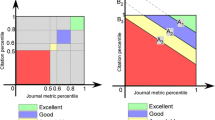Abstract
This paper focuses on the dichotomy between the multifaceted and multidimensional nature of contemporary R&D activity and unidimensional approaches to the measurement of its performance. While publications in refereed journals and citations are the most preferred indicators of research performance, there are also other indicators such as chapters in edited books, research reports, patents, algorithms, prototypes and designs, etc., which cannot be overlooked. Even when multiple indicators are used, they are used in isolation with the result that one gets only partial views of a multidimensional manifold. Here, a major problem is how to construct a composite measure of research performance, without assigning arbitrary weights to different measures of research output. This problem is particularly important for cross-institutional and cross-national comparisons of research performance. In this paper we have demonstrated the feasibility of constructing a multi-objective measure of research performance using Partial Order Scoring (POSCOR) algorithm developed by Hunya (1976). The algorithm is briefly described and applied to the empirical data on research outputs of 1460 research units in different socio-cultural, institutional and disciplinary settings. The potentialities and limitations of using POSCOR algorithm in scientometric analysis are briefly discussed.
Similar content being viewed by others
References
ANON (January, 1993), Research Performance Indicators Survey, National Board of Employment, Education and Training, Commissioned Report No. 21, Australian Government Publishing Service, Canberra, Australia.
BACKES-GELLNER, D. SADOWSKI (1990), Organizational implementation of bibliometric indicators, Scientometrics, 18: 385-395.
BHARGAVA, M., C. DUBELLAR, S. RAMASWAMI (1994), Reconciling diverse measures of performance: A conceptual framework and test of a methodology, Journal of Business Research, 31: 233-246.
BIRNBAUM, P. H. (1979), Some relationship between job satisfaction and organizational climate, Journal of Applied Psychology, 59: 318-328.
BRAUN, T., W. GLäNZEL, A. SCHUBERT (1993), Scientometric indicators datafiles, 1980-1989, Scientometrics, 28: 137-150.
BRAUN, T., W. GLäNZEL, H. MACZELKA, A. SCHUBERT (1994), World science in the eighties: National performances in publication output and citation impact, 1985-1989 versus 1980-1984, Part I: All science fields combined, physics and chemistry, Scientometrics, 29: 299-334, Part II: Life sciences, engineering, and mathematics, Scientometrics, 31: 3-30.
COLE, G. (1979), Classifying research units by performance and influence: Typology of Round 1 data, In: F.M. ANDREWS (Ed.) Scientific Productivity, UNESCO; Cambridge University Press.
COOPER, W. W., A. COOPER, L. M. SEIFORD (2000 a), Data Envelopment Analysis: Theory, Methods and Applications, Dordrecht: Kluwer Academic Publishers.
COOPER, W. W., L. M. SEIFORD, K. TONE (2000 b), Data Envelopment Analysis: A Comprehensive Text with Models, Applications, References and DEA-Solver Software, Dordrecht: Kluwer Academic Publishers (page XIX).
DE HEMPTINNE, Y., F. M. ANDREWS (1979), The international study on the organization and performance of research units: An overview, In: F. M. ANDREWS (Ed.), Scientific Productivity, UNESCO: Cambridge University Press.
FOX, M. F. (1983), Publication productivity among scientists: A critical review, Social Studies of Science, 13: 285-305.
GRUPPE, H., S. MAITAL, A. FRENKEL, K. KOSCHTZKY (1992), A data envelopment analysis to compare technological excellence and export sales of Israel and European Community countries, Research Evaluation, 87-101.
HAGSTROM, W.O. (1965), The Scientific Community, New York: Basic Books.
HUNYA, P. (1976), A Ranking Procedure Based on Partially Ordered Sets, Internal Report, József Attila University, Laboratory of Cybernetics, Szeged (Hungary).
IRVINE, J. (1989), Evaluation of scientific institutions: Lessons from a bibliometric study of a UK Technical university, In: D. EVERED, S. HARNET (Eds), The Evaluation of Scientific Research, John Wiley & Sons.
JOHNES, G., J. JOHNES (1992), Apples and oranges: The aggregation problem in publication analysis, Scientometrics, 25: 353-365.
JOHNES, G., J. JOHNES (1993), Measuring the research performance of UK Economics departments: An application of data envelopment analysis, Oxford Economics Papers, 45: 323-347.
KEENEY, R., H. RAIFFA (1993), Decisions with Multiple Objectives. Preferences and Value Tradeoffs, New York: Cambridge University Press.
KOSTOFF, R. N. (1992), Research impact assessment, Paper presented at the Third International Conference on Management of Technology, Miami, FL (USA), 19-21 February.
KOSTOFF, R. N. (1996), The Handbook of Research Impact Assessment, DTIC Report No. ADA 296021, Arlington, VA (USA): Office of Naval Research, (page.37).
MARCSON, S. (1966), Scientists in Organizations: Business and Government, Brunswick, NJ (USA): Rutgers University Press.
MARK, M., G. T. HENRY, G. JULNES (2000), Evaluation: an Integrated Framework for Understanding, Guiding and Improving Policies and Programs, San-Francisco, CA: Jossey-Bass.
MAZLISH, B. (1982), The quality of science-An evaluation, In: M. C. LaFallote (Ed.), Quality of Science, Cambridge: MIT Press, 48-67.
NAGPAUL, P. S. (1987), Organization and Efficiency of Research Groups, New Delhi (India): National Institute of Science, Technology and Development Studies.
NAGPAUL, P. S. (2001), Guide to Advanced Data Analysis Using IDAMS Software, http://www.unesco.org/idams
ROGERS, M., L. BRUEN, Y. MAYSTRE (1999), ELECTRE and Decision Support – Methods and Applications in Engineering and Infrastructure Investment, Kluwer Academic Publishers, Boston.
ROUSSEAU, S., R. ROUSSEAU (1997), Data envelopment analysis as a tool for constructing scientometric indicators, Scientometrics, 40: 45-56.
ROUSSEAU, S., R. ROUSSEAU (1998), The scientific wealth of European nations: Taking effectiveness into account, Scientmetrics, 42: 75-87.
ROY, B. (1991), The outranking approach and the foundations of ELECTRE methods, Theory and Decision, 31: 49-73.
ROY, B. (1990), Decision-aid and decision-making, European Journal of Operational Research, 45: 324-331.
ROY, B., D. VANDERPOOTEN (1996), The European School of MCDA: A historical review, Journal of Multi-Criteria Decision Analysis, 5: 22-38.
TRIANTAPHYLLOU, E. (2000), Multicriteria Decision Making Methods: A Comparative Study, Kluwer Academic Press.
WEBER, M., K. BORCHRDING (1993), Behavioral influences on weight judgments in multiattribute decision making, European Journal of Operational Research, 67: 1-12.
Author information
Authors and Affiliations
Rights and permissions
About this article
Cite this article
Nagpaul, P.S., Roy, S. Constructing a multi-objective measure of research performance. Scientometrics 56, 383–402 (2003). https://doi.org/10.1023/A:1022382904996
Issue Date:
DOI: https://doi.org/10.1023/A:1022382904996



